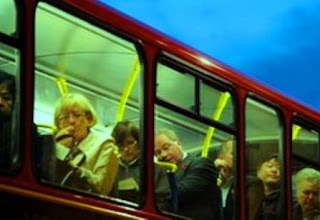# 67
An exhibition of Manet’s portraiture continues at the Royal Academy
Manet’s milieu was that of the leisured 19th Century Parisian bourgeoisie. His subjects were largely his family and his friends. An urban man throughout his life, Manet had a “wide circle of literary, artistic, musical and political friends who defended his art, served as sitters for his portraits and took roles in his scenes of contemporary life.”[i] Music in the Tuileries Gardens
Manet’s cultural milieu : a detail from Music in the Tuileries Gardens.
Manet is the figure at the extreme left.
Entirely consistent with gender attitudes of the time, Manet depicts the women as encased, passive and figuratively grounded. His men are almost all standing, some are mobile, most have the capacity to be active; but only, perhaps, as flâneurs. They celebrate their status as the idle rich; loafers and strollers of the boulevards to a man. In 1862, however, the painting was highly controversial. The French Academy
Leaving the RA sometime after 8pm we made our way to Olivelli, a commendable and affordable Italian restaurant in Waterloo
My urban milieu : late last Friday
Before this exhibition, I had not previously been aware of Manet’s painting The Railway, 1873. In this, Victorine Meurent models for him as an enigmatic young woman looking up from the pages of her book as an unseen steam train departs from the Gare Saint-Lazare. Her fingers secure references to several pages in the book and a puppy snoozes in her lap. This is painting as a snapshot, capturing a single, unrepeatable, moment in time. It is very clearly a painting made at the beginning of the age of photography. In a moment, the steam will vanish, the puppy will awaken, the little girl will turn around or the young woman may glance again at her book. It is even possible that Manet himself will appear at his studio door (in the background, to the left of Victorine’s head). In all respects The Railway is a truly modern painting, obedient to the new, impressionist, injunction to paint the effect, not the object.
Edouard Manet, The Railway, 1873
London, Gare de Waterloo, one hundred and forty years later.
Awaiting the night bus in the rain, an immigrant worker keeps his thoughts to himself in a composition not entirely dissimilar to Manet’s, but perforce without the background of steam and the fair little girl. Manet, I believe, would at least have approved the volume and intensity of the blackness all around the lonely individual and the transient, unsettling, discomfort suggested by the glossy redness of the narrow seat.
Le déjeuner sur l’herbe, 1862-3
But then, a Waterloo
Confidence and vulnerability on the night bus.
The night bus takes some of us home but others – minimum wage cleaners and security guards – may be heading back to work. Confidence enables sleep, it’s their economic situation that renders them vulnerable. Transport for London






No comments:
Post a Comment